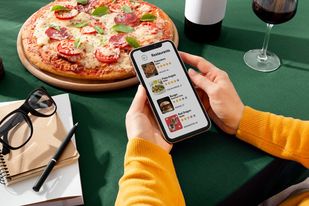Introduction:
Food apps, in today’s world, operate an important purpose in boosting the growth of food businesses, such as restaurants and food franchises. Given the ongoing need for food-related services, investing in food apps may be an income-generating prospect for food business owners, allowing them to profit on the food industry’s constant profitability and perhaps double their profits.
The rise of food apps is one of the primary drivers of this transformation. The food delivery app development company can provide most-perfect food applications for food businesses. These applications have transformed how customers discover, order, and enjoy food, making them a vital tool for food-related enterprises. In this post, we’ll look at the several reasons why your company has to invest in food applications to stay competitive and grow in an ever-changing environment.
1. Convenience and Preference of Customers:
Food apps have become the embodiment of streamlined, hassle-free eating experiences in an era where convenience reigns supreme. Consumers increasingly value convenience, and food apps provide a one-stop shop. These applications give a smooth experience that corresponds with current lifestyles, whether it’s browsing menus, placing orders, or scheduling delivery. Businesses may respond to the interests of their target audience by investing in food applications, thereby increasing consumer happiness and loyalty.
2. Wider Reach and Increased Visibility:
Food apps serve as effective marketing platforms, expanding a company’s reach well beyond the boundaries of its physical location. These apps often have a big user base, giving businesses a unique opportunity to tap into a broader market. Furthermore, the prominence provided by these platforms enables tiny, local establishments to compete on a worldwide scale. Investing in food apps is a strategic step for businesses trying to extend their client base and increase income. It improves exposure and offers up new possibilities for growth.
3. Enhanced Customer Engagement:
Food applications thrive in interactivity, which is a vital component of current customer engagement. Through features like tailored suggestions, loyalty programs, and real-time updates, these platforms enable businesses to communicate with their consumers. Businesses may keep their customers updated about discounts, new menu items, and special events by utilizing push notifications and in-app messaging. This degree of interaction strengthens the bond between businesses and their customers, resulting in enhanced brand loyalty.
4. Data-Driven Insights for Informed Decision-Making:
Food apps produce a plethora of data from which businesses may acquire significant insights into customer behavior. Businesses may use this data to make educated judgments regarding menu offerings, pricing tactics, and marketing initiatives, ranging from order history to preferences. This data-driven strategy enables organizations to personalize their services to their target audience’s individual wants and preferences, eventually optimizing operations for improved efficiency and profitability.
5. Efficient Order Management and Automation:
Order management is critical for restaurants and food enterprises to maintain a good level of service. Food applications simplify the ordering procedure, minimizing the possibility of mistakes and increasing overall efficiency. Order tracking and interaction with point-of-sale systems, for example, contribute to a more fluid workflow. Businesses may improve operational efficiency, decrease human mistakes, and provide a more enjoyable experience to their consumers by investing in culinary applications.
6. Consumer Behavior Change Adaptation:
The COVID-19 epidemic has expedited the transition toward digital solutions in several industries, including the food industry. Contactless eating, internet ordering, and meal delivery have all become the norm. Food app investments reflect a company’s capacity to react to changing consumer behavior and tastes. This adaptability is critical for long-term success, particularly in a setting where client expectations are continuously changing.
7. Competitive Edge in the Market:
Businesses must differentiate themselves in order to stand out in an increasingly competitive market. Food applications may help you create a one-of-a-kind and unforgettable client experience. Businesses may utilize these platforms to differentiate themselves from the competition by offering special in-app promotions, loyalty benefits, or novel features. Investing in culinary applications not only keeps businesses current, but also promotes them as innovative and customer-focused.
8. Revenue Growth through Delivery Services:
Food delivery services have been popular among customers who want the convenience of eating restaurant-quality meals in the comfort of their own homes. Businesses may increase their income by connecting with meal delivery applications. These applications offer a ready-made infrastructure for delivery logistics, allowing businesses to extend their services without having to spend much on their own delivery fleet. This variety of revenue streams can considerably help to overall corporate growth.
9. Positive Impact on Operational Efficiency:
Food applications improve not only customer-facing elements but also help to streamline internal processes. Inventory management, order monitoring, and real-time analytics all improve operational efficiency. Routine job automation decreases staff effort, allowing them to focus on providing great service. Businesses may establish a well-oiled machine that offers consistent quality while lowering operational expense by investing in culinary applications.
10. Adherence to Sustainable Practices:
Businesses are increasingly encouraged to embrace sustainable practices in an era of increased environmental awareness. Food apps make it easier to adopt environmentally friendly efforts including digital menus, electronic receipts, and efficient delivery routes. Businesses may present themselves as environmentally sensitive by decreasing paper waste and carbon emissions associated with inefficient delivery routes, connecting with consumers who value sustainability.
11. Integration with Emerging Technologies:
Food applications are not static things; they change in tandem with technology. Integrating upcoming technologies such as augmented reality (AR) and artificial intelligence (AI) might improve the user experience even more. AR, for example, may be used to deliver interactive menu experiences to customers, allowing them to envision food before ordering. Chatbots powered by AI may manage client queries, reservations, and feedback, allowing for more efficient and personalized service. Businesses may stay at the forefront of innovation and create unique experiences for their consumers by investing in culinary applications that use these technologies.
12. Cultivating Customer Loyalty:
Loyalty programs inside food applications are effective strategies for client retention. By giving special discounts, tailored suggestions, or points-based prizes, businesses may motivate repeat orders and develop a sense of loyalty within their consumer base. These loyalty programs not only motivate consumers to return to a certain location, but they also act as a significant marketing tool, since pleased customers are more likely to tell their friends and family about their pleasant experiences.
13. Flexibility in Menu Management:
Food apps provide companies the freedom to experiment with their offerings. Businesses may simply add or delete products, provide seasonal specials, or alter prices with real-time updates, eliminating the need for paper menus. This flexibility helps organizations to respond swiftly to market developments as well as adjust to changing consumer preferences. Businesses may display their innovation, keep their offers new, and remain responsive to the changing nature of the food sector by using this flexibility.
14. Enhanced Customer Feedback and Reviews:
Feedback and evaluations are critical in developing a company’s reputation. Food applications allow users to share their experiences, which contributes to a transparent feedback loop. Positive reviews may serve as powerful recommendations, enticing new consumers, but constructive criticism might give useful insights for development. Businesses may demonstrate their dedication to customer happiness and constantly improve their offers by actively interacting with client feedback on these channels.
15. Global Exposure for Local Businesses:
Food apps cut down geographical borders, allowing even small enterprises to reach a worldwide audience. Tourists and newcomers frequently use these apps to find local restaurants. Businesses may tap into the tourist sector and attract a wide spectrum of clients by having a presence on popular culinary apps. This worldwide exposure not only increases income but also helps to establish a strong brand reputation outside of the local community.
16. Crisis Resilience and Business Continuity:
Recent global events have emphasized the need of having several revenue streams and adaptable company structures. Food apps, with their online ordering and delivery capabilities, can save lives in the event of a pandemic or natural disaster. Businesses that invest in food applications may build a robust infrastructure that allows them to adjust swiftly to changing conditions, assuring company continuity even in difficult times.
17. The utilization of Social Media:
Food applications frequently interact smoothly with social media platforms, enhancing a company’s online exposure. Customers may immediately post their orders, images of delectable food, and reviews on social media, resulting in user-generated material that serves as free promotion. Businesses may utilize user-generated content to improve their brand image, connect with a larger audience, and capitalize on social media’s importance in affecting consumer decisions.
18. Regulatory Transparency and Compliance:
Various rules govern the food sector, including food safety standards and labeling requirements. Food applications make it easier for companies to stay in compliance with these requirements. Businesses may develop trust with customers who are increasingly mindful about what they consume by clearly showing nutritional information, ingredient specifications, and adherence to dietary preferences. This transparency helps to build a favorable brand image and builds customer trust in the quality and integrity of the items or services provided.
19. Collaboration Opportunities:
Food applications frequently encourage commercial relationships and cooperation. Joint marketing, cross-selling, and partnerships with delivery services may broaden a company’s reach and introduce it to new client categories. Businesses may develop synergies within the sector, expand their network, and explore novel methods to sell their services by actively participating in the collaborative features given by food apps.
20. Constant Change in Consumer Expectations:
Consumer expectations are always changing as a result of technology improvements and shifting cultural standards. Businesses that invest in food applications position themselves to respond to changing consumer demands. The capacity of these applications to accept new features, technologies, and trends ensures that businesses remain relevant and continue to fulfill the different demands of their consumer base. Stagnation in the face of fast technological development may result in market share loss, making continual investment in food applications a strategic need.
Conclusion:
If you want your food delivery service to thrive, you must develop a bespoke app. All you need to do is employ a respectable iOS app development company with expertise developing on-demand food delivery apps. The transparency and convenience provided by the on-demand delivery app builder solutions for the food delivery app benefit both app users and merchants. Due to the market’s recent expansion, it is critical to design a unique mobile application if you wish to develop an on-demand food delivery app.





